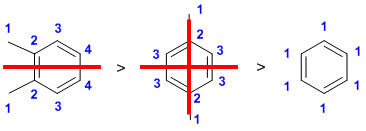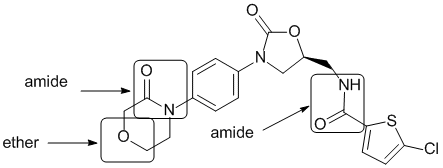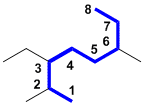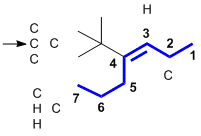| Qu1: |
Acidity...There is an alkane (CH), an alcohol (OH) and an amine (NH). Based on HA <=> H+ + A-, we should look at the stability of the conjugate basse, A-. The negative charge will be on C, O or N.... atoms from the same row of the periodic table so electronegativity will be important. A more electronegative atom will stablise the -ve charge more. The pKas for alkanes > 50, alcohols approx = 15 and amines approx. 35. Therefore the acidity is alcohol > amine > alkane. (v1= C, v2 = A) |
 |
| Qu 2: |
C-H bond strength depends on the hybridisation of the C atom. sp2 hybrid orbitals have more s character and so are smaller which leads to shorter, stronger bonds. The proximity of a p system (here an arene) makes adjacent C-H bonds weaker (the e rich character of the p system allows the adjacent C-H bonds to lengthen and therefore weaken). The effect of the adjacent p system is greated than the difference between 2o and 3o (about 10 vs 3 kcal/mol). See table for reference. (v1= B, v2 =E) |
 |
| Qu 3: |
Basicity...Think about the availability of the electrons in the bases, always a good idea to draw in the lone pairs because lone pairs are more available than bonded pairs. Amines are more basic than amides (N lone pair involved in resonance, O more electronegative) and ammonium ions don't have electrons that are readily donated because all the valence electrons are involved in bonds. (v1= A, v2 = AB) |
 |
Qu 4: |
Radical stability order. Radicals are stabilised by alkyl groups, so tertiary are the most stable and primary the least stable. Resonance also stabilises radicals. Vinyl radicals are less stable than alkyl radicals due to the low energy of the orbital that contains the single electron (less stabilisation). Alternatively, the most stable radical will be obtained from breaking the weakest bond (3o, allylic) and the least stable radical from breaking the strongest bond (vinyl sp2).(v1= A, v2 =E) |
 |
| Qu 5: |
Acidity... The H attached to the O in the acid will be the most acidic (has the most stable conjugate base). The other two are both C-H systems, and both have resonance stablisation of the conjugate base to electronegative O atoms.... but one can delocalise to two O the other only 1. (v1= A, v2 = AB) |
 |
| Qu 6: |
Ranking resonance structures... Normally look to maximise the number of bonds or atoms with complete octets and minimise charge separation. Carbocations are C atoms with incomplete octets while the O+ still has a complete octet. The key here is starting with the right structure from the reaction of the ketone with the acid. (v1= A, v2 = AB) |
 |
| Qu 7: |
Boiling point is a physical property and is therefore controlled by intermolecular forces. The system with the strongest intermolecular forces will have the highest boiling point. Alcohols have H on electronegative atoms and therefore can participate in H-bonding interactions, which are stronger than induced dipole - induced dipole intermolecular forces. So the alcohol will have the highest boiling point. If we look at the two isomeric alkanes, they have different branching. More branching makes the alkane more spherical and decreases the surface areas in contact - this means less intermolecular forces and therefore a low boiling point. (v1= B, v2 = E) |
 |
| Qu 8: |
Counting types ? (v1= D, v2 = AB) |
 |
MOLECULAR PROPERTIES:
No real method here, really just do you know various aspects of molecular structure and apply it to the molecule(s) in question. |
| Qu9: |
The structure contains 4 rings, 5 C=C and 3 C=O therefore index of hydrogen defficiency = 4 + 5 + 3 = 12. (v1 D, v2 D) |
| Qu10: |
Oxidation states...count the bonds attached to the atom being considered. A bond to a more electronegative atoms counts -1, a bond to the same type of atom counts 0 and a bond to a less electronegative atom (e.g. H) counts +1. Total the count and then consider the formal charge on the central atom since the oxidation state for the central atom plus the groups attached must equal the atoms formal charge. For C2 the C is attached to 1 x C (count 0), 1 x O (count -1) and 2 x H (count +1 each) therefore total = +1 and therefore the oxidation state C2 = -1. (v1= D, v2 = AB) |
| Qu11: |
Functional groups.... (v1 = BC, v2 = AD)

|
| Qu12: |
O1 is attached to two sp3 C. This means it is a simple ether and the lone pairs are in sp3 hybrid orbitals. (v1= A, v2 = A) |
| Qu13: |
C14 is attached to two H atoms, an sp3 C atom and an N so C14 is sp3 hybridised.
N16 is
adjacent to a C=O (like an amide) and therefore in order to allow the N lone pair to interact with the pi system, the N is sp2. (v1 = B, v2 = C) |
| Qu14: |
C15 is attached to 1 other C and is therefore primary, hence it is a primary H. (v1 = A, v2 = C) |
| Qu15: |
C13 is attached to 2 other C and is therefore secondary. (v1 = B, v2 = D) |
| Qu16: |
For C13 assign the R/S stereochemistry, using the Cahn-Ingold-Prelog rules to assign group priorities....O > CH2NC2 > CH2NCH > H. Since the lowest priority group, the H is at the back and so the sense of the 3 higher priority groups (1-2-3) is counter clockwise = S (build a model or visualise). (v1 = C, v2 = C) |
| Qu17: |
The N atoms in amides are less basic than the O due to the resonance interaction of the lone pairs with the C=O.... or, draw the resonance of the protonated species (v1 = E, v2 = E) |
SPECTROSCOPY:
Use the IR spectra provided to get the functional groups that are present in the structures, so look for the key groups : C=O (near 1700 cm-1) , -OH or -NH (above 3000 cm-1), aromatic C=C (two bands 1600-1400 cm-1), C-O (near 1200 cm-1) and triple bonds (near 2200 cm-1).... use the tables as needed. |
| Qu18: |
The IR shows a C=O a little above 1700 cm-1. The IR does not show -OH or -NH, or C=C, or triple bonds, and no real sign of C-O. On closer inspection, the C-H stretches are < 3000 cm-1 indicating sp3 C-H only. This would be consistent with the ketone. (v1 = AE, v2 = AE) |
 |
| Qu19: |
The IR does not show a C=O near 1700 cm-1 but it does show a strong and broad OH stretch at 2500-3500 cm-1. On closer inspection, the C-H stretches are < 3000 cm-1 indicating sp3 C-H only. This would be consistent with an simple alcohol (not aromatic). (v1 = AB, v2 = AC) |
 |
| Qu20: |
The IR shows a C=O a little above 1700 cm-1. The IR does not show -OH or -NH, or C=C, or triple bonds, but there is a C-O near 1200 cm-1 On closer inspection, the C-H stretches are < 3000 cm-1 indicating sp3 C-H only. This would be consistent with the ester. (v1 = BC, v2 = AD) |
 |
| Qu21: |
The IR shows two strong C=O stretches above 1800 and near 1750 cm-1, this is indicative of the acid anhydride. (v1 = AD, v2 = BC) |
 |
| Qu22: |
The IR does not show a C=O near 1700 cm-1 but it does show a strong, double -NH2 stretch at about 3400 cm-1. On closer inspection, the C-H stretches are > 3000 cm-1 indicating sp2 C-H only. This would be consistent with aniline (benzene and amine). (v1 = C, v2 = D) |
 |
| Qu23: |
The IR does not show a C=O, -OH or -NH or C=C. There looks to be a triple bond near 2100 cm-1 and on closer inspection, the C-H stretches at 3300 cm-1 indicating an sp C-H of a terminal alkyne. (v1 = CD, v2 = CD) |
 |
NOMENCLATURE:
Two types of questions here, however it is a good idea to use key descriptors like E and Z, R or S, cis or trans, numbering, functional group etc. to help screen the answers before getting too tied up in the words. For the first four, name the compound and then match it to the list, for the last four
use the key descriptors and check each molecule in turn. So this section really depends on the nomenclature rules. |
| Qu24: |
An alkane with the longest chain C8, so an octane. Keeping the substituents simple, there are three substituents, a simple ethyl group and two methyl groups. The first point of difference dictates using 2,3,6 over 3,6,7 and alphabetisation means that the dimethyl group is named after the ethyl group since the multiplier is ignored when alphabetising such systems. Hence, 3-ethyl-2,6-dimethyloctane. (v1 = E, v2 = D) |
 |
| Qu25: |
The longest chain containing the C=C is C7, so a heptene. Number to give the ketone the lowest number means hept-3-ene. At C4 there is a complex substituent, a 1,1-dmethylethyl group. The double bond is E (priority groups on opposite sides) so we have E-4-(1,1-dimethylethyl)hept-3-ene. (v1 A, v2 D) |
 |
| Qu26: |
The principle functional group is the alkene and those two C atoms need to be 1 and 2. It's a five membered ring (cyclopentene). Then the first point of difference rule requires that the system be numbered as a with the ethyl group at C3 rather than methyl at C4. Alphabetisation means that the ethyl group needs to be before the methyl group. This means we have 3-ethyl-4-methylcyclopentene. (v1 = AB, v2 = B) |
 |
| Qu27: |
The largest ring is C6 so a cyclohexane. We have an cyclopropyl substituent which needs to be numbered as 1- due to alphabetisation in preference to the methyl group. Hence we have 1-cyclopropyl-3-methylcyclohexane. (v1 = A, v2 = B) |
|
| Qu28: |
All of the systems are ethers, it's all about the common alkyl substituents.
t-butyl is -C(CH3)3 and isopropyl is -CH(CH3)2. (v1 = C, v2 = B) |
 |
| Qu29: |
Substituted benzenes and an ester. The ethyl group forms the alcohol part of teh ester and the methyl group is on the benzene. meta means the two groups are 1,3- to each other. (v1 = A, v2 = C) |
 |
| Qu30: |
R/S stereochemistry and E/Z stereochemistry
Chirality center is marked with a *. Priority of groups there is OH > C=C > C > H. With OH forwards, the chirality is R, so we need the OH to be back.
Double bond has CH3 > H and CO > CC therefore, higher priority groups need to be on the same side = to be Z. (v1 =B, v2 = A) |
 |
| Qu31: |
The bicyclic system is an octene meaning 8C and an alkene. The [2.2.1] indicates the number of C is each link between the bridgehead carbons. Need to start to number from a bridgehead, going along the longer link containing the C=C to locate C2 for the alkene and the methyl group. (v1 = E, v2 = E) |
 |


















